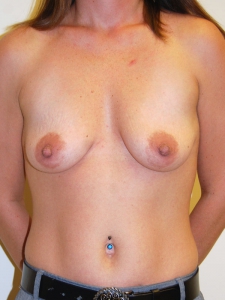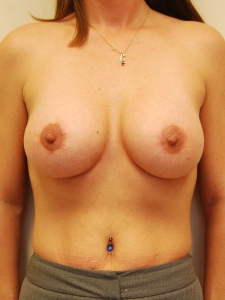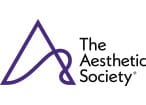Breast Lift with Implants
 Many of the women who visit Richmond Aesthetic Surgery desire breasts that appear youthful, symmetrical, and proportionate in size with the rest of their body. Though breast augmentation can offer an increase in cup size, improving the overall shape and firmness of the breasts often involves more than simply adding volume. A breast lift (mastopexy) in addition to breast augmentation can tighten and tone the skin to both lift and reshape the breasts, while simultaneously raising the nipple and areola to a more youthful position.
Many of the women who visit Richmond Aesthetic Surgery desire breasts that appear youthful, symmetrical, and proportionate in size with the rest of their body. Though breast augmentation can offer an increase in cup size, improving the overall shape and firmness of the breasts often involves more than simply adding volume. A breast lift (mastopexy) in addition to breast augmentation can tighten and tone the skin to both lift and reshape the breasts, while simultaneously raising the nipple and areola to a more youthful position.
- Breast Lift Candidates
- Breast Lift With vs. Without Implants
- What Is a Breast Lift with Implants?
- Breast Lift with Implants Before and After Photos
- Types of Breast Lifts
- Breast Lift with Implants Procedure
- Risks of Breast Lift with Implants
- Breast Lift Recovery
- Breast Lift with Implants Cost
- Additional FAQs About Breast Lift with Implants
Am I a Breast Lift Candidate?
Women who choose breast lift surgery often feel their breasts look “deflated” due to excess or loose skin, or that the nipples and areolas are much lower on the breasts than in their youth. In addition, sagging breasts can make it more difficult to find clothing that fits properly. Ptosis or sagging breasts can be the result of:
- Pregnancy
- Breast-feeding
- Genetics
- Sun exposure
- The natural aging process
By restoring the breasts, nipples, and areolas to a more youthful position on the chest and eliminating excess skin, Dr. Neil J. Zemmel can use a breast lift to help women achieve their pre-pregnancy shape or to reverse the stretching and sagging that typically results from age.
Should I Receive a Breast Lift With or Without Implants?
The decision to undergo breast augmentation, a breast lift, or a combination of both procedures is dependent on your individual aesthetic goals and the starting condition of your breasts. If you want to improve the shape of the breasts and simply raise the position of the nipple and areola, a breast lift may be right for you. If you want to increase your cup size, maintain the extra fullness of the breasts you had during pregnancy, or further enhance your natural shape and volume, breast augmentation may be the best option for you. Many of our patients require a combination of techniques in order to obtain the optimal shape and volume. The factors that will influence the need for a breast augmentation, or a breast lift, or a combination, are:
- The cup size and volume of your breasts
- The degree of skin laxity and the presence of stretch marks
- The amount and distribution of breast tissue within the breast
- The position and shape of the crease (inframammary fold) on each side
- Overall breast symmetry
- The combined thickness of breast tissue and skin
- The shape of the rib cage, breast bone, and pectoralis muscle
- The position and size of the nipples and areolas on the breasts
- The width of your chest
- The length of your torso and width of your hips
The degree of ptosis (sagging) can be divided into the following stages:
- Grade 0 (No Ptosis): The nipple and areola are located above the level of the inframammary fold and are located at the most anterior projecting point of the breast.
- Grade I (Mild Ptosis): The nipple and areola are located at the level of the inframammary fold and a significant amount of breast tissue is located below the fold. The nipple is located at the most projecting portion of the breast.
- Grade II (Moderate Ptosis): The nipple and areola are located below the breast fold and the majority of breast tissue is located below the fold and nipple. The nipple is located nearly on the most anterior projecting point of the breast.
- Grade III (Advanced Ptosis): The nipple and areola and located far below the inframammary crease. Nearly all of the breast tissue is located below the inframammary crease.
- Grade IV (Severe Ptosis): The nipple and areola are located far below the crease and point downwards. Most of the breast tissue is located below the level of the inframammary fold.
- Pseudoptosis: The nipple and areola are located at the level of the inframammary crease, but the majority of breast tissue is located below the crease.

Women who desire a breast lift but have a minimum amount of breast tissue may also require breast implants to achieve their expectations. In addition, sometimes sagging of the breasts is actually caused by a loss of breast volume rather than an excess of stretched skin. In these cases, breast implants can serve as the foundation for maintaining a youthful shape and position to the breasts, and can provide longer-lasting results.
During your consultation, our board-certified breast augmentation surgeon, Dr. Neil J. Zemmel, will perform an examination and discuss your personal aesthetic goals and expectations. Using this information, he will work with you to design an approach for your breast surgery that can best meet your unique needs.
What is a Breast Lift with Implants?
Women who have satisfactory breast volume, but whose breasts are located lower on the chest wall, may benefit from a breast implant and a lift. A breast lift alone will not restore shape to the upper portion of the breast.
Breast Lift with Implants Before and After Pictures
For a look at the types of results you can achieve when undergoing a breast lift with implants procedure at Richmond Aesthetic Surgery, visit our breast lift with implants gallery. Before and after pictures of our patients help demonstrate Dr. Zemmel’s surgical expertise with improving sagging breast tissue and restoring breast fullness.
What Are the Types of Breast Lift Techniques?
At Richmond Aesthetic Surgery, Dr. Zemmel will employ one of four lifting techniques for your breast lift, depending on the amount of lift required. The lifts described below become progressively more powerful. The longer the distance your nipple will be raised, the more powerful the required lift. Each of these lifts is designed to raise the level of the breasts, nipples, and areolas, and differs to accommodate varying amounts of excess skin and the current position of the breasts. To help you decide which of these lift types might best meet your expectations, your surgeon will perform a physical examination and make a recommendation based on how each type of lift can improve the overall shape of the breasts.
- Crescent Breast Lift (Mastopexy): A crescent mastopexy provides the smallest amount of lift of all the lift types. If you need to raise the nipple and areola approximately 1 to 2 cm, your surgeon may recommend this lift, usually in combination with an implant. Because it is not a powerful lift, Dr. Zemmel rarely uses this technique. The technique is performed by removing a small moon-shaped (crescent) area of skin around the upper perimeter of the nipple and areola from the 9:00 position to the 3:00 position. Closing the skin edges lifts the nipple and areola into the new position. After the procedure, this type of incision is well-hidden along the outer edge of the areola.
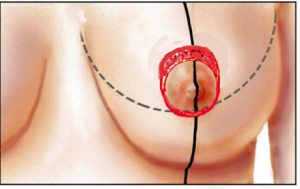
- Periareolar Breast Lift (Mastopexy): Also known as a concentric, doughnut, or Benelli mastopexy, this lift type can tighten the skin of the breasts while reducing the diameter of the areolas. A periareolar mastopexy is used most frequently if you wish to combine your lift with a breast augmentation. This lift has a number of excellent uses, including raising the nipple and areola 2 to 4 cm, tightening the front projecting skin of the breast, and reducing the areolar diameter. After making a circular incision around the areola, any excess skin of the areola or breast skin is removed. The outer and inner circular skin incisions are then closed with a permanent suture to “lock in” the diameter of the areola and prevent any future areolar stretch. Post-operatively, this incision remains well-hidden along the border of the areola and is barely visible once healing is complete.
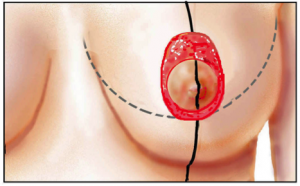
- Vertical Breast Lift (Mastopexy): A vertical mastopexy may be used if you have a larger amount of excess skin or higher degree of sagging (ptosis) than can be sufficiently corrected with either a crescent or periareolar mastopexy. A vertical mastopexy will raise the nipple and areola 3 to 6 cm and reduce the diameter of the areola as well. When executing a vertical mastopexy, Dr. Zemmel makes a circular incision around the areola as well as a vertical incision below the areola, creating a “lollipop” shape. This incision type allows a greater amount of excess horizontal skin to be removed, a more comprehensive tightening and lifting of the breast, and can fully restore the breasts to a more youthful position. A vertical mastopexy can also be successfully combined with breast augmentation, depending on the volume and shape requirements.
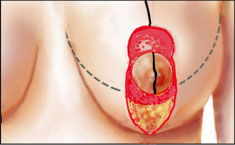
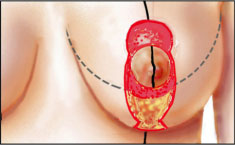
- Full Mastopexy (Mastopexy): A full mastopexy is recommended when Dr. Zemmel believes a sufficient lift is not possible using any of the prior lift types. It is typically used in patients with Grade III/IV ptosis of the breast. This means the nipple and areola are located significantly below the inframammary fold (the breast crease) and even pointing downwards. In addition to the incisions used in a vertical mastopexy, an additional incision along the crease beneath the breast is also needed to produce a significant lift and give a youthful shape to the breast. Although this lift type requires more incisions than the others, the incisions usually heal very well. The resulting scars fade over time. Dr. Zemmel’s patients are uniformly happy to accept any remaining marks in exchange for the benefit of a fully rejuvenated breast shape with a beautiful contour.
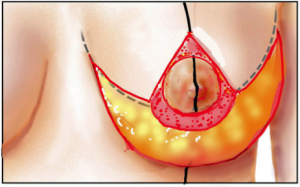
What Does the Breast Lift with Implants Procedure Entail?
Breast augmentation alone takes approximately 50 minutes, and depending on which of the four lift types your surgeon uses, the procedure usually lasts between 1 ½ and 2 ½ hours total. Your procedure will be performed under deep sedation or general anesthesia in the main operating rooms of the hospital.
When determining which approach will be used, your surgeon will assess the amount of excess skin that needs to be removed in order to create a significant lift and reposition the nipples and areolas to a more youthful position. Regardless of which lift type is employed, breast lift incisions typically heal very well. Dr. Zemmel uses a meticulous, gentle surgical technique to minimize blood loss and bruising. This will greatly speed your recovery. Dr. Zemmel uses the same incisions utilized in the mastopexy to create the breast implant pocket, therefore reducing the total number of incisions. All incisions are closed with thin, non-reactive absorbable sutures that do not require post-operative removal and, more importantly, result in the thinnest, least visible scar.
Since Dr. Zemmel understands that breast lift surgery and breast augmentation is a very personal choice for every woman, he spends time during the consultation process listening to your goals and expectations, providing his professional recommendations on which type of lift or implant can best achieve your desired results, and helps you make a well-educated decision about your body and health.
Are There Any Risks to a Breast Lift with Implants?
Breast augmentation-mastopexy is a complex operation that changes nearly every dimension of the breasts. It requires not only inserting and managing a breast implant, but also an expert knowledge of the soft tissue dynamics covering the implant. It should be performed only by a board-certified plastic surgeon. As with any surgery, there is some risk, and it is Dr. Zemmel’s primary concern to minimize any risks associated with your procedure. Dr. Zemmel prioritizes his patients’ safety and comfort when performing a breast lift with implants to yield the best possible results. He maximizes your safety by:
- Using only accredited hospital operating rooms.
- Working with board-certified anesthesiologists and nurse anesthetists.
- Maintaining a consistent operating room team to help ensure reliable results and a smooth surgery.
- Using only the highest-quality instruments and materials for your procedure.
- Closely following up with each breast lift-breast implant patient to help ensure a rapid and comfortable recovery.
As with any surgery, there is a risk of complications or negative reactions to anesthesia. Bleeding or infection can occur. Fortunately these complications are rare and occur less than 1% of the time. It is possible for your scars to widen over time. Your surgeon will prescribe medical grade scar cream after surgery to help soften and settle the scars.
A small amount of asymmetry is normal and natural after surgery. You will not have an exact copy of the right and left breasts. Many factors beyond the surgeon’s control influence the final shape of the breasts. The size and shape of the pectoralis muscles, the shape of the rib cage, differences between the right and left ribs, and the shape of the breast bone all influence your final shape. During your pre-operative breast surgery consultation, your surgeon will go over any pre-existing asymmetries in detail. Dr. Zemmel spends a significant amount of time during the consultation process to educate patients about all possible risks and complications so that they can make well-informed decisions about the surgery.
Breast Lift with Augmentation Recovery
The specifics of your recovery will vary slightly, depending upon your procedure or combination of procedures. For example, if your breast augmentation mastopexy is part of a mommy makeover, you will likely need to stay in the hospital overnight after your procedure. The recovery time for a crescent or periareolar mastopexy is typically a day or two. The recovery time for a full mastopexy combined with breast augmentation can take 5-10 days.
Your first post-operative appointment with your surgeon will be within the first two days of surgery. You will be given oral pain medication for any physical discomfort as well as detailed instructions on bandage care, showering, and recommended activity restrictions. Your specific recommended activity level will depend on how quickly you move through the healing process. Most patients experience a tight or swollen sensation after their procedure, and some liken the sensation to the way their breasts felt during pregnancy or while breast-feeding. Within three to five days, these side effects typically subside, at which point the soft surgical bra can be replaced with a sports bra.
Depending on the incision type used for your breast lift and whether you have opted to combine your mastopexy with another procedure, you will likely be able to resume your normal daily activities within three to seven days. Strenuous physical activity and exercise should be suspended for several weeks, though patients are typically able to perform light cardio workouts after two weeks. Within four weeks of surgery, you should be able to resume your normal exercise routine.
Dr. Zemmel recommends that you begin a scar treatment regime two weeks after your breast lift with implants. By beginning scar treatment as quickly and aggressively as possible, you can greatly minimize the final appearance of the incisions, leaving only light, soft scars that can easily blend with the contours of the breast.
The full healing process for a breast lift can take 6-18 months, depending on the patient. As your body continues to heal, you should notice your results improve.
Throughout your entire recovery, your surgeon and our knowledgeable staff will be available to you. If you have any sudden questions or concerns, you can always visit our office or contact us by phone. After your initial follow-up appointment, we will see you every five to seven days to monitor your progress and help ensure the best possible results. With meticulous post-operative care provided by Richmond Aesthetic Surgery, Dr. Zemmel believes our patients achieve significantly better outcomes, as well as increased satisfaction with their new look.
How Much Does a Breast Lift with Implants Cost?
The cost of breast lift surgery with implants is typically similar to that of breast augmentation. Since Dr. Zemmel creates customized surgical plans for each patient—based on their unique goals and physical needs—there is no fixed cost for the breast lift with implants procedure. Factors that may affect the amount you pay include:
- Type of breast implants
- Complexity of your procedure
- Geographic location of the practice
- Expertise of the plastic surgeon
- Anesthesia fees
- Hospital costs
During the consultation process, your surgeon will provide you with a personalized cost quote covering the various fees involved with your breast lift with implants procedure. If you have any questions, please don’t hesitate to ask our staff. We can also provide you with resources for our financing options, assisting you with enrollment if you choose to do so.
In addition, our team offers CosmetAssure® for patients who are interested. This cosmetic surgery insurance program provides coverage should a rare complication occur after the breast lift with implants procedure.
Additional FAQs About Breast Lift with Implants
How Do You Sleep After a Breast Lift with Implants?
For the first couple months after your breast lift with implants procedure, you should sleep on your back and avoid resting on your stomach. This is important to ensure you heal properly, allowing the scar tissue to fully form around each implant. When sleeping on your stomach or side, the implant can be shifted and affect the final result.
Even if you have undergone a breast lift without implants, you should make sure to sleep on your back to avoid putting excess pressure on the incisions, which can lead to more swelling, additional discomfort, and a more significant scar appearance. Sleeping on your back provides the best possible position for the breasts to heal after surgery.
How Can I Reduce Swelling After My Breast Lift with Implants?
Swelling is normal after any breast surgery, and this can make your breasts appear larger than expected at first. It is important to remember swelling will fade, and your final results will gradually become more noticeable. Most swelling subsides within 4 to 6 weeks after breast lift surgery. To help minimize swelling, you will be instructed to wear the post-operative dressings and an elastic bandage or support bra for the first part of your recovery. Using a cool compress for about 20 minutes several times per day can also help reduce inflammation and swelling. If you are concerned about your swelling, you should contact your plastic surgeon to learn if what you are experiencing is normal.
When Can I Exercise After My Breast Lift with Implants?
You will be encouraged to walk around and be lightly active during your recovery. For the first 2 weeks, you should avoid lifting your arms above your head and lifting objects more than 5 pounds. After this time, patients can usually resume light cardio. You should be able to return to more strenuous exercise after about four weeks.
Is it Possible to Lift Your Breasts Naturally?
Although there are many articles claiming that certain chest exercises can help lift the breasts naturally, achieving a significant breast lift is not possible without surgery. Over time, the skin and ligaments tend to stretch and loosen, causing the breasts to take on a sagging appearance. This lax tissue cannot achieve a youthful, “perky” lift unless excess skin is removed and the remaining skin is tightened—such as in the breast lift procedure.
Contact Us
To learn more about breast lift procedures, combining a breast lift with breast augmentation, or to schedule a consultation, please contact us today.
